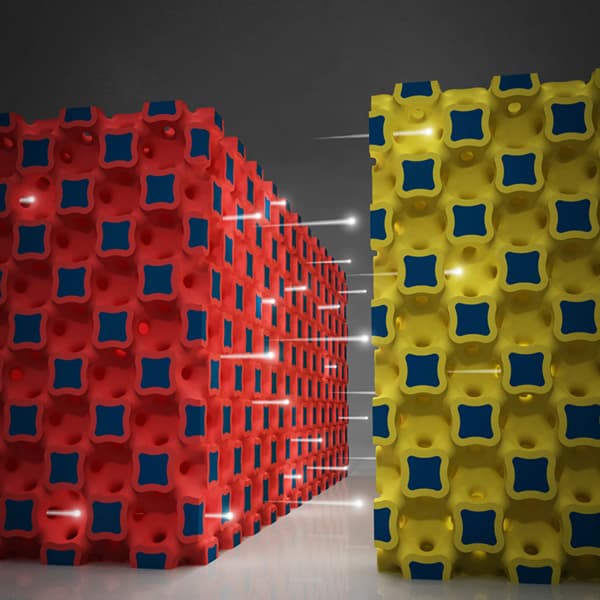Tiny Li-Ion Batteries Charge 1000x Faster; May Make Gadgets 30x Smaller
Lithium Ion (li-ion) batteries are more important than ever, in the history of electronics. With the never ending obsession of engineers to develop thinner and more efficient gadgets, batteries have to get smaller and deliver more power. The photo below is a graphic illustration of a ion-exchange beween 3D micro-electrodes of a high power battery. This tiny battery has been developed at the University of Illinois by a team of researchers led by William P. King who's a professor of Mechanical Science & Engineering. The research was published in the April 16 issue of the Nature Communications.
 Image Credit: Image courtesy of the Beckman Institute for Advanced Science and Technology
Image Credit: Image courtesy of the Beckman Institute for Advanced Science and Technology
King calls it a whole new way of thinking about batteries. The challenge was to develop a battery that'd deliver more power in lesser time and take lesser charging time. Capacitors can release energy quickly but there are limitions on energy they can store. The tradeoff is between energy & power. James Pikul, a grad student and author of the research paper says that if you want high energy then you have to sacrifice high power and vice-versa. However, for the modern electronics we need a perfect balance of both.
The new micro-batteries offer high power and energy at the same time by having a tweaked structure. Researchers were able to tune the batteries over wide range of power/energy scale. The team used fast charging cathode and a matching anode to make the battery with a far superior performance. The team says that their battery charges 1000x faster than rivals and has potential to make gadgets 30x smaller. It will also allow transmitters to broadcast signals 30 times farther. The team is currently working on integrating their new batteries with other electronic components.
We look forward to credit-card sized phones. What about you?

King calls it a whole new way of thinking about batteries. The challenge was to develop a battery that'd deliver more power in lesser time and take lesser charging time. Capacitors can release energy quickly but there are limitions on energy they can store. The tradeoff is between energy & power. James Pikul, a grad student and author of the research paper says that if you want high energy then you have to sacrifice high power and vice-versa. However, for the modern electronics we need a perfect balance of both.
The new micro-batteries offer high power and energy at the same time by having a tweaked structure. Researchers were able to tune the batteries over wide range of power/energy scale. The team used fast charging cathode and a matching anode to make the battery with a far superior performance. The team says that their battery charges 1000x faster than rivals and has potential to make gadgets 30x smaller. It will also allow transmitters to broadcast signals 30 times farther. The team is currently working on integrating their new batteries with other electronic components.
We look forward to credit-card sized phones. What about you?
Replies
-
 GurjapC'mon Kastubh, moar sources please 😀 this is fascinating stuff. I wonder how they solved the deep cycle/overall life tradeoff problem, if they have that is.
GurjapC'mon Kastubh, moar sources please 😀 this is fascinating stuff. I wonder how they solved the deep cycle/overall life tradeoff problem, if they have that is. -
 Kaustubh KatdareMy apologies. I forgot to mention the source. Check: #-Link-Snipped-#
Kaustubh KatdareMy apologies. I forgot to mention the source. Check: #-Link-Snipped-# -
 GurjapNo details on the actual process they've employed. Have they merely caused the electrodes to be super-spongy? Proprietary information, perhaps?
GurjapNo details on the actual process they've employed. Have they merely caused the electrodes to be super-spongy? Proprietary information, perhaps?
You are reading an archived discussion.
Related Posts
Why? What? Where? How? - these were the basic questions in our past, which lead to many inventions and discoveries that we know of.
But today, its not likely to...
help me complete ma M.Tech project in POWER QUALITY ANALYSER USIN LABVIEW. i need to complete it within two months
Warm wishes to all,
I am here to be a part of this community by communicating with the other members of this forum. This is a very nice place for...
The Antikythera mechanism built in Greece before Christ is considered to be the world's oldest computer.
https://blog.fora.tv/2013/04/deciphe...a5ed3364-Newsletter_04_17_13&utm_medium=email
I do not know how accurate this prediction is.
Presented here for whatever can be made of it.
https://in.finance.yahoo.com/photos/...ow/the-best-jobs-in-2013-photo-394155857.html
